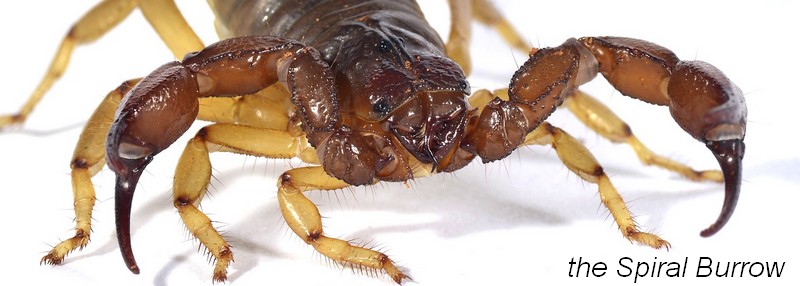
Welcome
Welcome to the Spiral Burrow, the world's most informative site on Australian Scorpions. I established this website many years ago in order to help people looking for information on our scorpion fauna as so little was available. Below you will find a general introduction to scorpions, on the features page there are numerous articles covering reproductive biology, adaptive physiology, morphology, husbandry and more. The species page gives images and information on a selection of our scorpion fauna, most of which are some of our most common species. The shop section is where you can purchase material related to Australian scorpions. I'm happy for non-commercial educational use of the images and information with credit, but please ask (email) if you wish to use images on a website or in any commercial venture.
The website name 'the Spiral Burrow' is derived from the spiral structure of the burrow of some desert dwelling species such as Urodacus yaschenkoi.
Enjoy the site, Mark A Newton
Introduction to Scorpions
Scorpions have successfully inhabited this planet largely unchanged for an immense period of time. Earliest ancestors date back 450 million years and were fully or partially aquatic. At some point in time around 325-350 million years ago scorpion ancestors made the transition to land as fully terrestrial invertebrates (Farley, 1999).
The earliest common ancestor is thought to have been the Euryptids, or "water scorpions" which share features with paleozoic scorpions such as, external book gills, flap-like abdominal appendages, large multifaceted compound eyes, and similar chewing structures on the coxae of the first pair of appendages. It's accepted that the earliest scorpions were at least partially aquatic due to the external gills, presence of legs suited to a benthic existence and in some cases large size where they would have needed water to support their bodies and accomplish ecdysis. The evolution of enclosed book lungs from the prior external lungs is the most prominent transition to a land existence.
 |
ClassificationKingdom: AnimaliaPhylum: Arthropoda Subphylum: Chelicerata Class: Arachnida Order: Scorpiones C.L.Koch, 1837 The arrows indicate the chelicerae or mouth parts, these are homologous to a spiders fangs and unite members of the subphylum chelicerata which include the:
Pycnogonida (sea-spiders) |
There is argument as to whether scorpions are arachnids or not. Some think scorpions are the earliest form of arachnid, giving rise to the other forms. Another view is that scorpions are not arachnids, but rather modern terrestrial merostomes, with the most common relative being the horseshoe crabs, Limulus. Whichever is the case its clear scorpions represent a distinct group from other arachnids.
Modern scorpions show little difference to the primitive forms of the Paleozoic era, other than the necessary changes in locomotion and respiration. The basic body plan has remained the same, proving to be more than suitable with it's continued existence right through to present day. This is also apparent from the observation that all modern scorpions are very much the same with little variation other than subtle morphological changes to suit environment. Desert species look like rainforest or littoral species, indicating that conservation of morphology is extremely high. This is also reflected in the observation that the reproductive biology and behavior is consistent throughout the various scorpion families.
Today, scorpions are found on every major landmass except Antarctica, and were introduced into New Zealand and England by man. They occupy a vast array of habitats, including deserts, tropical rainforests, savanna, grasslands, temperate rainforests, intertidal zones and even snow covered mountains. Even though scorpions are morphologically conservative they are quite adaptable, being found in extreme and diverse conditions.
Scorpions are predacious, feeding mainly on arthropods including their own kind. They are also known to prey on reptiles, frogs and rodents. With very low metabolic rates scorpions are capable of going long periods without eating and spend much of their lives dormant within a burrow. A single meal can make up one third or more of their body weight, with little waste probably largely brought about by the process of external digestion. Prey to body mass conversion is very high in scorpions, with excreta being mostly acid with little water content. The cuticle is covered with a waxy layer to give very low water loss from the cuticle, hence scorpions show excellent water retention abilities.
Growth occurs mainly via shedding of the cuticle, producing the next instar or growth stage with each shed. Sexual maturity occurs after the final molt, with no further molting taking place. Depending on the species the number of molts to adulthood varies but is most often 5-6 times. Young are born live, climb onto their mother's back and remain there until some time after their first moult, after which they leave to fend for themselves.
Have a look at the Features section for detailed information on a range of topics.